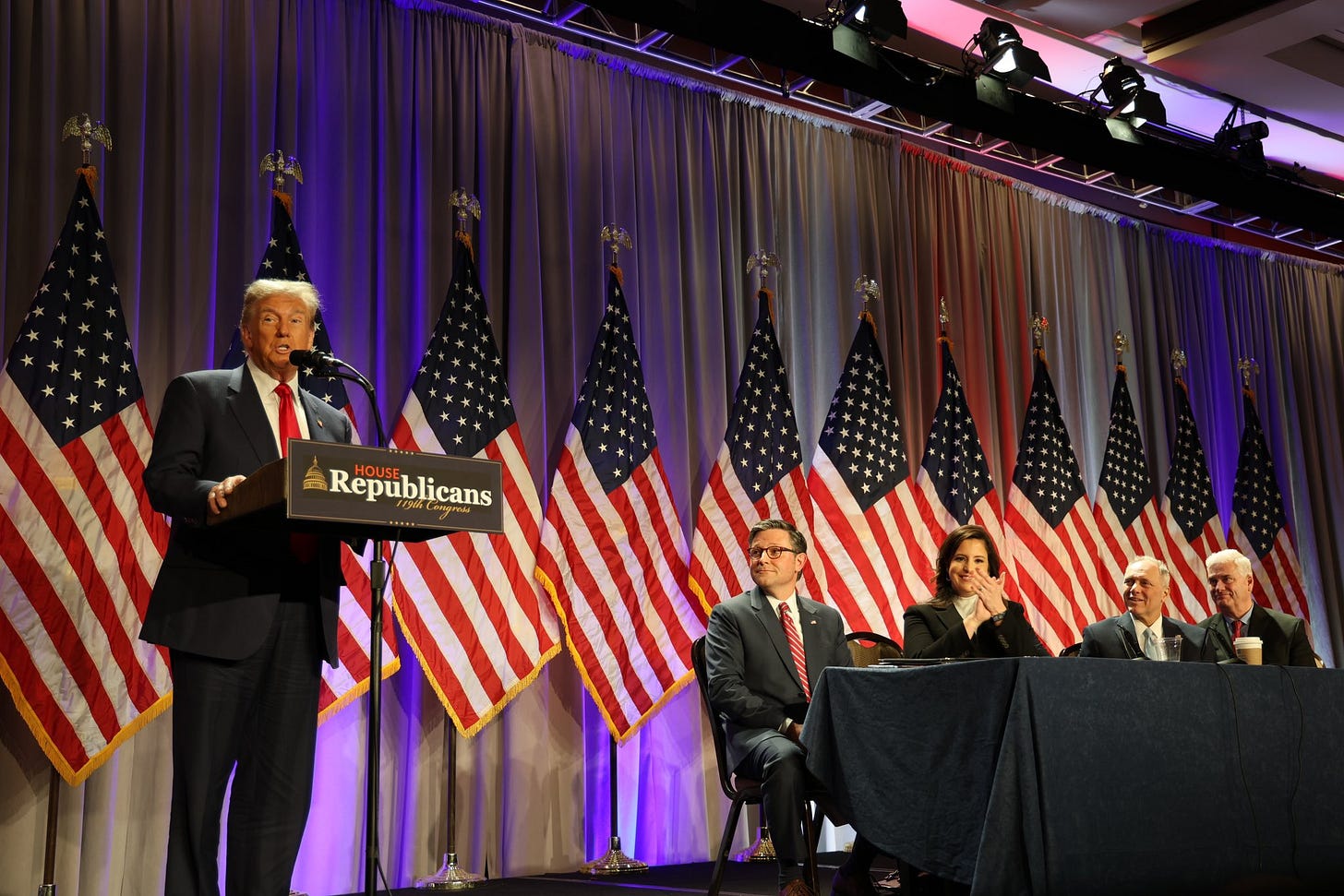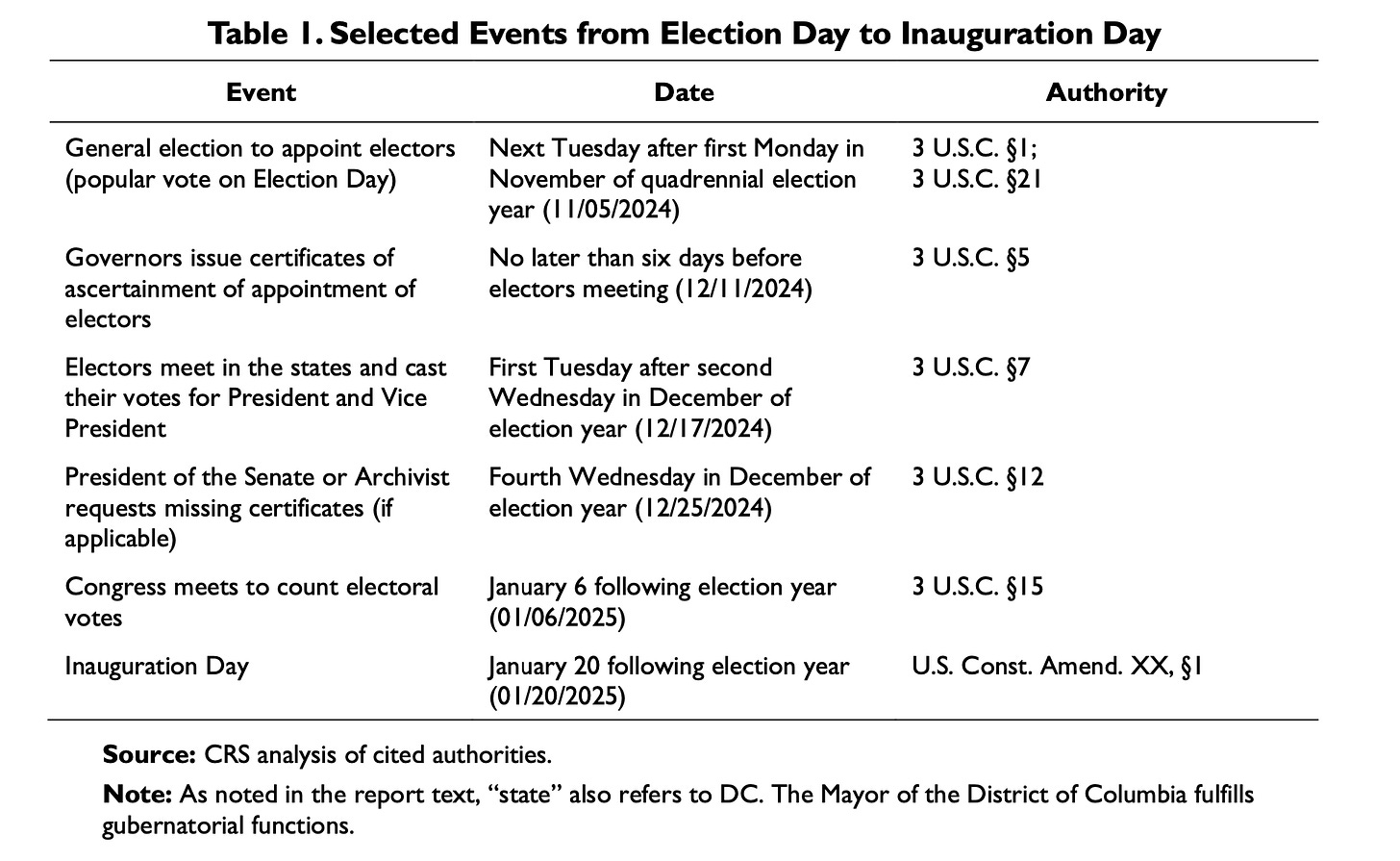What we’ve learned from the Trump transition, Part I
Taking stock of the past nine weeks — and looking ahead at the next few months.
Good morning! It’s Tuesday, January 7, 2025. Inauguration Day is 13 days away. If you’re one of the 60 million Americans caught in Winter Storm Blair, I hope you’re staying warm.

Nine weeks have now passed since Election Day. Donald Trump’s inauguration is less than two weeks away. The second Trump presidency is almost here.
This fact was affirmed yesterday by the U.S. Congress, which counted the 2024 electoral votes and found — surprise! — that Donald Trump had won 312 of them and Kamala Harris had won 226.
Here’s a video of that moment, narrated by Harris herself:
The whole process took only 30 minutes, down from almost 15 hours in 2021. (It helps not to have a riot in between.) It was the first electoral vote count in 12 years not to feature any objections from the losing party.
As this handy table from the Congressional Research Service shows, that means we have reached the end of the line of legally mandated steps to verify the election results. All that’s left now is the actual swearing-in:
With that in mind, I thought this would be a good time to check in on the Trump transition and review what we’ve learned in the last two months about how his second term is shaping up to look.
From my vantage point, the Trump transition has been characterized by four main qualities: impressive speed, factional strife (sometimes leading to a lack of clarity over the agenda), a diminished opposition, and lots of trolling.
I’m going to unpack two of these qualities in this morning’s newsletter and the other two tomorrow. Let’s dive in:
1. Impressive speed. When a new president takes office, they don’t just have to fill the high-profile jobs like Secretary of State or Attorney General. In total, they have to appoint people to about 4,000 political positions across the federal government. (If you want to read the full list, it’s published every four years in a document known as the Plum Book, although the tome also includes about 3,000 career positions that roll over between administrations.)
CBS News reported yesterday that Trump’s transition team is on track to fall short of its goal for how many of these appointees they wanted to have in place by Inauguration Day — which sounds like a misstep, until you consider that their goal was 2,000, which is very high. Trump in 2017 and Biden in 2021 only had around 1,200 appointees in place by the time they took office; if the Trump team even gets close to hitting their target, it will represent a much faster clip for filling the government than has been the norm.
This chart from Ballotpedia shows how fast Trump was in filling the 23 Cabinet-level posts this time around: he was done within 29 days of the election — compared to 69 days for Biden and 72 days for Trump 2017.
But what has been most striking to me has been his speed in announcing lower-profile positions too, firing off Truth Social posts to name everyone from the next deputy chief of staff at the Treasury Department to the head of the Federal Railroad Administration. Joe Biden didn’t name his first ambassadors until April 2021, three months into his term. Trump has already named dozens, rewarding allies with postings like the Bahamas, Estonia, and Malta (jobs that sometimes take years to fill).
Does this mean Trump is suddenly diving into the nitty-gritty details of railroad policy? Maybe. More likely, this speed seems to reflect a team — led by incoming chief of staff Susie Wiles — that is much better organized than his last, chaotic transition effort. In a way unlike any incoming administration since 1893, this isn’t their first go-around: Trump and his advisers know the terrain; at this point, some of them have been working together for almost a decade.
They’ve also benefitted from a constellation of outside groups that were doing a lot of legwork during the Trump interregnum: despite distancing themselves from the effort, for example, transition officials has been “taking suggestions for potential hires from the extensive personnel database created by Project 2025,” NBC News has reported.
The speed can also be attributed to the fact that Trump is working off instinct, making snap judgements about many of his picks. That’s risky, of course, but — with the lone high-profile exception of Matt Gaetz — seems to be paying off.
Senate confirmation hearings for Trump’s nominees are set to begin next week, and none of them appear to be particularly endangered at this point. Senate Majority Leader John Thune (R-SD) has reportedly communicated to Trump that controversial Defense Secretary nominee Pete Hegseth has the votes to be confirmed; if you believe the bettors at Polymarket, none of the Trump picks have worse than three-fourths odds of getting in.

2. Factional strife. The best part of Trump blasting off so many personnel announcements on Truth Social has been the occasionally revelatory insights into his thinking that have been sprinkled throughout. (Most of the announcements are just rote recitations of the appointee’s résumé, but every once in a while, you get a gem.)
My favorite one, so far, has been last week’s announcement of Morgan Ortagus as Deputy Special Presidential Envoy for Middle East Peace. Here’s an excerpt:
Early on Morgan fought me for three years, but hopefully has learned her lesson. These things usually don’t work out, but she has strong Republican support, and I’m not doing this for me, I’m doing it for them. Let’s see what happens. She will hopefully be an asset to Steve, a great leader and talent, as we seek to bring calm and prosperity to a very troubled region. I expect great results, and soon!
“I’m not doing this for me, I’m doing it for them.” Every presidential administration includes picks to please various factions within a president’s coalition — look no further than Joe Biden appointing all those Elizabeth Warren aides, for example — but you rarely see it spoken out loud like that.
Then again, unusually public signs of intra-party tension have been a theme of Trump 2.0 so far.
The most obvious example has been the fight over H-1B visas, which was fought bitterly on MAGA Twitter during Christmas break. There was also a dispute over the year-end spending bill, which included a mini-dispute over the debt ceiling. Late last week, House Speaker Mike Johnson (R-LA) was re-elected, but not without three initial dissenters and signs that others did so only grudgingly. (As has been noted elsewhere, exactly nine House Republicans — the same number now needed to trigger a vote on Johnson’s ouster — either voted against Johnson or waited until the end of the roll call to vote for him. Hmm.)
We can derive a few takeaways here. One is the emergence of new power centers, most notably Elon Musk, who almost singlehandedly tanked the spending bill and won Trump over (at least for now) on H-1Bs. Another is Trump’s influence over Congress — and its limits. He is likely to get most of his Cabinet picks confirmed…but not Matt Gaetz. He succeeded in getting Republicans to change course on spending…but not on the debt ceiling. He got his choice of speaker…but not without having to push.
In Trump 2.0, it’s basically off-limits for Republicans to signal opposition to Trump himself, but if you oppose Trump’s wishes by saying you’re doing “what’s best for the Trump agenda,” you can often get a pass.
Then again, what is the Trump agenda? All the squabbling can sometimes give way to confusion. Even on his biggest campaign promises, advisers are clearly clashing over how far to go behind the scenes, as seen in the Washington Post’s report on Monday that Trump’s aides are exploring plans to significantly pare back Trump’s proposed tariffs.
Trump was quick to brand the story as “Fake News” — and maybe it is. But, after nine years of going through this merry-go-round, my bet would be that the story (and Trump’s response) are signs that different parts of Trumpworld want different things, and they’re all trying to leak in order to advance their preferences. On this fight, as with the others, the policy consequences of which faction wins will not be small.
And we haven’t even gotten into the biggest disagreement, over how to write the new administration’s signature piece(s) of legislation.
Republican leaders in the House and Senate have a big split on how to advance Trump’s top priorities: either in one “big, beautiful bill” combining border security, energy, tax policy, and more (the approach favored by the House) or with two separate reconciliation packages, one for the border and one for everything else (the approach favored by the Senate).
The one-bill route might make it easier to get everyone in line, since a “nay” vote would equal tanking almost the party’s entire legislative output. The two-bill route gives a higher likelihood of getting something done in the first few months, since drafting the tax portions is expected to take a lot of time.
Trump, as ever, is being vague about where he stands. He sent out a Truth on Sunday endorsing the one-bill approach… but then told Hugh Hewitt on Monday that he’s actually agnostic on the question, re-opening the debate anew. Asked by Politico which option Trump preferred, Sen. Tommy Tuberville (R-AL) responded: “What day is it?”
Expect a lot of work this week to pick a path, and fast. Thune and Johnson are set to meet today. Then, Trump is poised to meet with Senate Republicans tomorrow and with different factions of House Republicans at the end of the week. The Trump team may be ahead on personnel, but — compared to their own precedent — they’re behind on reconciliation, a process that already takes a lot of time.
By this point in 2017, the Senate had already begun work on the budget resolution to unlock the reconciliation process for Obamacare repeal, the first step in the first (and ultimately unsuccessful) legislative push of Trump 1.0. This time around, Republicans haven’t even decided how many budget resolutions there will be, much less started advancing one.
More news to know
NPR: Biden makes an 11th-hour move to block coastal oil drilling / NBC: Biden administration finalizes rule to strike medical debt from credit reports
Politico: Trump urges Garland to block release of Jack Smith’s final report
ABC: Judge holds Giuliani in contempt for failing to turn over property to 2 Georgia election workers
NYT: U.S. Sends 11 Guantánamo Prisoners to Oman to Start New Lives
The day ahead
All times Eastern
President Biden will travel to Thermal, California, where he will deliver remarks at 5:15 p.m. to announce two new national monuments: the Chuckwalla National Monument and the Sáttítla Highlands National Monument, protecting a combined 848,000 acres significant to Native tribes from drilling and mining.
President-elect Trump will hold a press conference at 11 a.m. at Mar-a-Lago.
VP Harris will deliver a eulogy at 4:30 p.m. at the ceremony welcoming former President Jimmy Carter’s body to the Capitol, where he will lie in state this week.
The Senate has no legislative business scheduled.
The House is set to begin debate on the Laken Riley Act, which would require the federal government to detain undocumented migrants charged with theft or burglary.
The Supreme Court has no oral arguments scheduled.





Sixth paragraph under “1. Impressive speed”: legWORK, not legroom.
Senator Tommy Tubberville's remark is priceless and very Trump Era oriented.